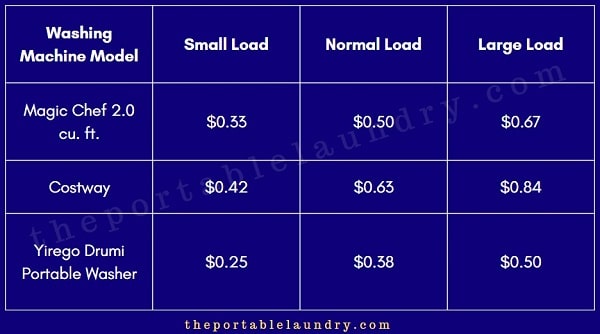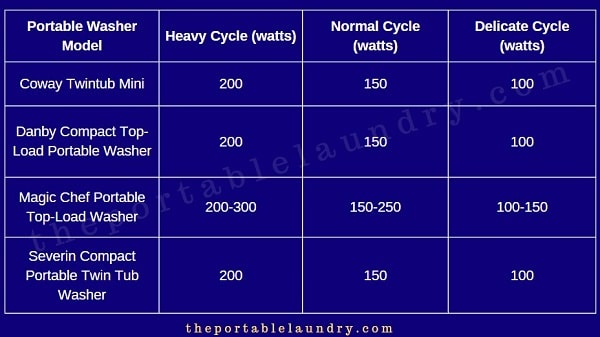With their compact design and efficiency focus, portable washers present a striking advantage when it comes to electricity consumption.
Portable washers use an average of 200 to 700 watts, which is significantly less than the average standard washing machine which has an energy consumption of 400 to 1400 watts. This means that portable washers can save you up to 50% on your energy costs for laundry.
In this article, we will walk through the factors that influence the energy consumption, average power consumption of a portable washer, and how much energy it can save.
Table of Contents
Factors Affecting the Electricity Consumption of Portable Washers
Several factors influence the electricity consumption of portable washers when considering their energy efficiency.
Understanding these variables can assist you in making informed choices to optimize laundry routines while minimizing energy usage.
Let’s dive right into the key aspects that impact how much electricity a portable washer uses:
Model and Size of the Washer
The specific design and dimensions of a portable washer can significantly affect its energy consumption.
Modern portable washer models are engineered with varying levels of energy efficiency.
Smaller, more compact models tend to consume less electricity due to their reduced capacity and streamlined operation.
It’s essential to explore energy-efficient portable washer models that align with your laundry needs while promoting sustainability.
Water Temperature
The water temperature setting you to choose for your laundry cycles can have a noticeable impact on energy consumption.
Hot water settings require additional energy to heat the water, contributing to higher electricity usage.
Opting for cooler water temperatures, such as using cold water or lukewarm settings, can substantially reduce energy demands without compromising the effectiveness of the washing process.
Cycle Length
The duration of washing cycles directly correlates with electricity consumption.
Longer cycles typically consume more energy, however, advancements in portable washer technology have led to the development of quick and efficient cycles that offer substantial energy savings.
Selecting shorter cycle lengths whenever possible can significantly decrease energy usage over time.
Load Size
The amount of laundry you load into the portable washer per cycle affects energy efficiency.
Overloading the washer can lead to less effective cleaning and potentially higher energy consumption as the machine works harder to accommodate the excess load.
Conversely, running smaller loads than the machine’s capacity can lead to unnecessary energy wastage.
Striking the right balance by maximizing load sizes without overburdening the washer is key to optimizing energy efficiency.
Energy-Saving Features and Technology
Many modern portable washer models come equipped with energy-saving features such as sensor technology that adjusts water levels and cycle durations based on load size.
These innovations contribute to minimizing electricity consumption by ensuring that resources are used efficiently throughout the washing process.
Spin Efficiency
The spin cycle of a portable washer plays a crucial role in energy consumption.
A higher spin speed can lead to more efficient water extraction, reducing the drying time needed afterward.
This indirectly contributes to energy savings by lowering the overall energy required for the laundry process.
By considering these factors, users can make conscious decisions to optimize their portable washer’s energy efficiency.
The Role of Motor and Heating Coil
The motor’s role in agitating and spinning the drum, coupled with the heating coil’s function in elevating water temperature, are critical drivers of electricity consumption.
The motor’s constant energy use remains relatively consistent across cycles, while the heating coil demands substantial energy for water heating.
This critical insight presents an opportunity to enhance energy efficiency, especially by opting for cold cycles.
The Components Driving Energy Consumption
To comprehend how energy-efficient portable washing machines truly are, it’s essential to break down the components that contribute to their energy consumption.
Motors, water heaters, valves, pumps, and control panels collectively play a role in determining the overall energy use.
By selecting models equipped with energy-efficient components, you can further optimize the energy consumption of your portable washer.
Per cycle cost of portable washers

These estimates assume:
- Electricity costs $0.12 per kWh.
- Detergent costs $0.50 per load.
- Actual costs per cycle may vary based on these factors and your chosen washing machine model.
Can Portable Washing Machine Save You Money?
Yes, a portable washing machine can save you money in several ways. First, it is generally less expensive to purchase than a full-sized machine. Second, it uses less water and electricity, reducing utility costs. Lastly, it eliminates or reduces the need to go to a laundromat, saving you both time and money on transportation and per-load costs.
However, these savings may be offset if you have large laundry loads, as portable machines have smaller capacities and may require multiple cycles
Overall, a portable washing machine can be a cost-effective option for small households, apartments, or situations where space and initial cost are considerations.
How to Save Energy with a Portable Washer?
As we strive for greater energy efficiency in our daily routines, employing smart practices with your portable washer can lead to substantial electricity savings over time.
Here are key strategies to consider for energy saving:
Opt for the Shortest Cleaning Cycle
Selecting the shortest cycle that effectively cleans your clothes reduces the overall energy consumption of the washer.
Many modern portable washers offer multiple cycle options tailored to different levels of cleaning intensity.
By choosing the cycle that matches your laundry’s needs without unnecessary prolongation, you contribute to both energy efficiency and quicker laundry completion.
Maximize Load Capacity
Efficiently utilizing your portable washer’s maximum load capacity can significantly impact energy usage.
Running full loads instead of partial ones optimizes each use, reducing the frequency of cycles and thus conserving electricity.
Be mindful not to overload the washer, which can affect cleaning effectiveness and potentially negate energy savings.
Using Cold Water
Opting for cold water whenever feasible is an effective way to cut down on energy consumption.
The water temperature factor in washing cycles can be a considerable contributor to electricity usage.
Washing clothes in cold water not only conserves energy but also safeguards fabrics from potential damage caused by hot water.
Modern detergents are formulated to work efficiently even in colder temperatures.
Harness Air Drying
One of the simplest yet impactful ways to save energy is by air-drying your clothes.
Portable washer users can further extend their energy savings by avoiding the use of energy-intensive dryers.
Hang your freshly laundered clothes on a clothesline or a drying rack to take advantage of natural air circulation.
Not only does this practice reduce electricity consumption, but it also helps extend the lifespan of your garments.
Leverage Energy-Efficient Features
Exploring your portable washer’s energy-efficient features can lead to substantial savings.
Some models offer options like delay start timers, allowing you to time your laundry cycle to coincide with off-peak electricity hours.
Others incorporate load sensors that adjust water usage based on the amount of laundry, minimizing wastage and optimizing energy efficiency.
Consider Energy Ratings and Settings
When choosing a portable washer, pay attention to its energy efficiency ratings.
Look for models with higher efficiency ratings, as these tend to consume less electricity over time.
Additionally, explore settings that promote energy savings explicitly, such as eco-friendly modes or quick wash options designed to limit energy consumption while maintaining effective cleaning.
Comparison of Electricity Consumption: Portable Washers vs Standard Washing Machines
When evaluating the electricity consumption of portable washers in comparison to standard washing machines, it’s essential to consider various factors that influence energy efficiency.
Let’s explore how these two laundry appliances measure up:
| Aspect | Portable Washers | Standard Washing Machines |
| Average Electricity Consumption | 200-300 watts | 400-1400 watts |
| Potential Energy Cost Savings | Can save up to 50% on energy costs for laundry | Can save up to 30% on energy costs for laundry if the load size is high for large family. |
| Space Considerations | Good option for people with limited space | More versatile than portable washers |
| Portability | Easy to move | Difficult to move |
To better understand the consumption differences, let’s take a look at the examples (Tabular Diagram):

As evident from the comparison, portable washers showcase lower electricity consumption, typically ranging from 200 to 300 watts.
This efficient energy use translates to potential savings of up to 50% on energy costs for laundry.
These washers are particularly advantageous for individuals with limited space, offering a compact solution that is easy to move when needed.
On the other hand, standard washing machines consume more electricity, with average consumption spanning from 400 to 1400 watts.
While they can still provide energy savings of around 30%, they offer more versatility in terms of load capacity and cycle options, making them suitable for larger families or those with diverse laundry needs.
Also Read: How to Calculate Power Consumption of Washing Machine?
Final Thoughts
Laundry’s role has expanded in trying to achieve sustainability, covering energy efficiency and careful usage.
Portable washers are at the center of this trend, providing convenience as well as significant reductions in electricity consumption.
Beyond usefulness, laundry technology now combines environmental awareness and cost-effectiveness.
Exploring factors influencing energy use and comparing portable washers to standard ones emphasizes the necessity of making informed selections.
Shorter cycle times, full loads, and cold water washing all enhance energy efficiency and good cleaning results.
You May Also Like
- Portable Washers: How They Work & their working principles
- How to Calculate Washing Machine Capacity? (With formula)
- How does an automatic washing machine choose water level?
- How much water does a washing machine use?
- How to Calculate Washing Machine Capacity? (With formula)
- Average Washing Machine Weight (with examples)
- What’s the Average Height of a Washing Machine?





